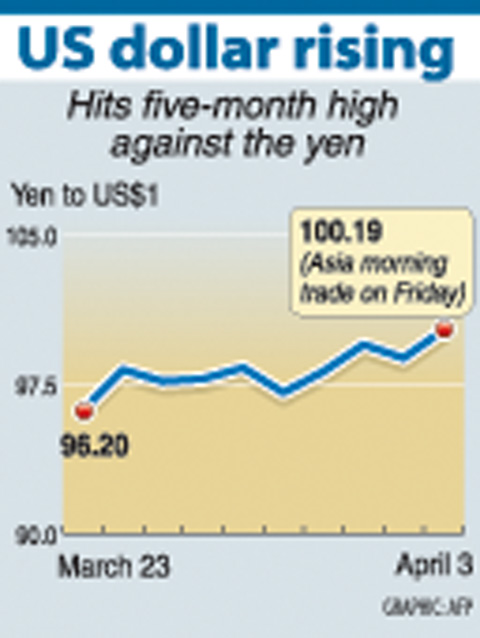The dollar topped ¥100 for the first time in five months but weakened against other major currencies on Friday as traders assessed the impact of a weak US employment on economic recovery prospects.
At 9pm GMT, the euro fetched US$1.3483 from US$1.3461 late on Thursday in New York.
The dollar meanwhile rose to ¥100.29 from ¥99.52 as investors welcomed the G20 summit pledge to step up efforts to tackle the economic crisis.

“The actions by Washington and leaders of the 20 largest economies have helped to restore risk appetite,” Kathy Lien at Global Forex Trading said.
In late New York trading, the dollar stood at 1.1301 Swiss francs from SF1.1340 on Thursday.
The pound was at US$1.4836 after US$1.4725.
Asian currencies rose for a fifth week, the longest winning streak since October 2007 in the wake of the G20 summit.
Eight of the 10 most active Asian currencies outside Japan advanced in the week after economic reports in China, the US and the UK fueled speculation that demand for regional exports will strengthen.
The Bloomberg-JPMorgan Asia Dollar Index, which tracks their performance, touched a two-month high on Thursday.
The South Korean won advanced 0.6 percent this week to 1,341.50 per dollar, according to data compiled by Bloomberg. The New Taiwan dollar climbed 1.2 percent to NT$33.38 and the Malaysian ringgit strengthened 1 percent to 3.5803.
The MSCI Asia-Pacific Index of regional equities climbed 1.4 percent during the week.
The NT dollar touched an 11-week high on Thursday before paring its advance on reported intervention. The central bank bought at least US$1.2 billion of US dollars on Thursday to counter foreign investors’ and local corporations’ purchases of the Taiwanese currency, the Taipei-based Economic Daily News said on Friday.
Elsewhere, the Singapore dollar climbed 0.6 percent this week to S$1.5051, Indonesia’s rupiah rose 0.2 percent to 11,475 and the Philippine peso gained 0.4 percent to 47.862.

Tropical Storm Gaemi strengthened into a typhoon at 2pm yesterday, and could make landfall in Yilan County tomorrow, the Central Weather Administration (CWA) said yesterday. The agency was scheduled to issue a sea warning at 11:30pm yesterday, and could issue a land warning later today. Gaemi was moving north-northwest at 4kph, carrying maximum sustained winds near its center of up to 118.8kph and gusts of 154.8kph. The circumference is forecast to reach eastern Taiwan tomorrow morning, with the center making landfall in Yilan County later that night before departing from the north coast, CWA weather forecaster Kuan Shin-ping (官欣平) said yesterday. Uncertainty remains and

SEA WARNING LIKELY: The storm, named Gaemi, could become a moderate typhoon on Wednesday or Thursday, with the Taipei City Government preparing for flooding A tropical depression east of the Philippines developed into a tropical storm named Gaemi at 2pm yesterday, and was moving toward eastern Taiwan, the Central Weather Administration (CWA) said. Gaemi could begin to affect Taiwan proper on Tuesday, lasting until Friday, and could develop into a moderate typhoon on Wednesday or Thursday, it said. A sea warning for Gaemi could be issued as early as Tuesday morning, it added. Gaemi, the third tropical storm in the Pacific Ocean this typhoon season, is projected to begin moving northwest today, and be closest to Taiwan on Wednesday or Thursday, the agency said. Today, there would likely

DISRUPTIONS: The high-speed rail is to operate as normal, while several airlines either canceled flights or announced early departures or late arrivals Schools and offices in 15 cities and counties are to be closed today due to Typhoon Gaemi, local governments announced last night. The 15 are: Taipei, New Taipei City, Taoyuan, Tainan, Keelung, Hsinchu and Kaohsiung, as well as Yilan, Hualien, Hsinchu, Miaoli, Chiayi, Pingtung, Penghu and Lienchiang counties. People should brace for torrential rainfall brought by the storm, with its center forecast to make landfall on the east coast between tonight and tomorrow morning, the Central Weather Administration (CWA) said. The agency issued a sea warning for the typhoon at 11:30pm on Monday, followed by a land warning at 11:30am yesterday. As of

CASUALTY: A 70-year-old woman was killed by a falling tree in Kaohsiung as the premier warned all government agencies to remain on high alert for the next 24 hours Schools and offices nationwide are to be closed for a second day today as Typhoon Gaemi crosses over the nation, bringing torrential rain and whipping winds. Gaemi was forecast to make landfall late last night. From Tuesday night, its outer band brought substantial rainfall and strong winds to the nation. As of 6:15pm last night, the typhoon’s center was 20km southeast of Hualien County, Central Weather Administration (CWA) data showed. It was moving at 19kph and had a radius of 250km. As of 3pm yesterday, one woman had died, while 58 people were injured, the Central Emergency Operation Center said. The 70-year-old